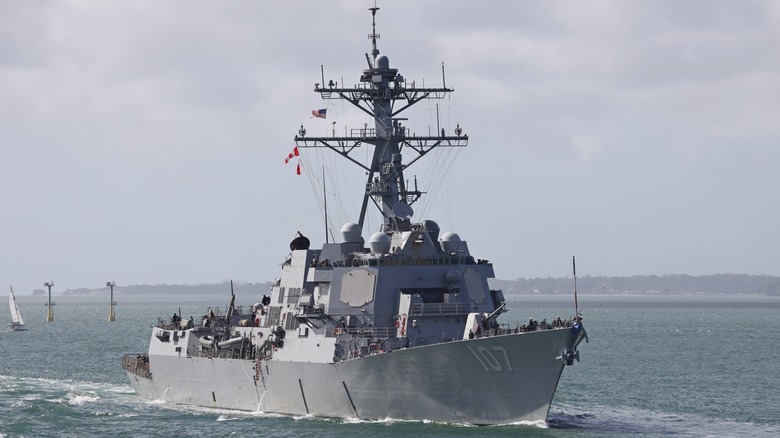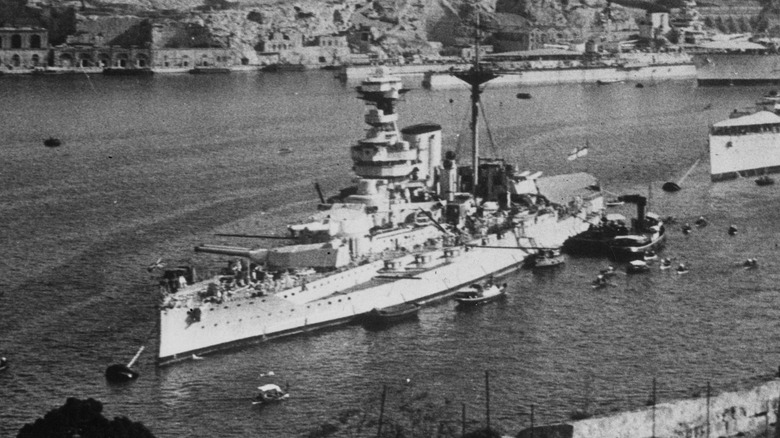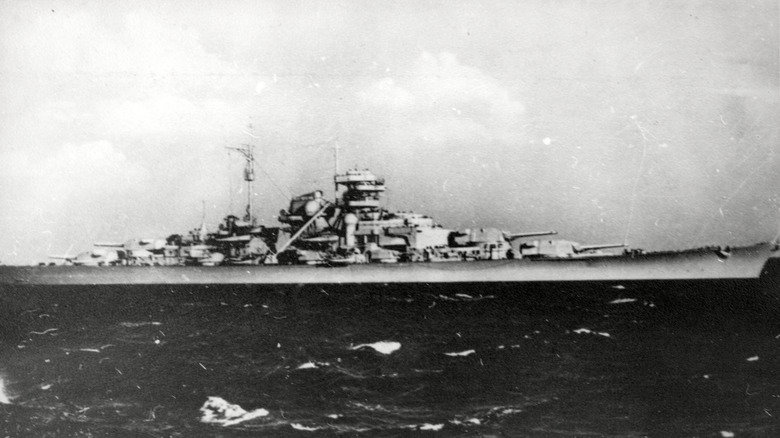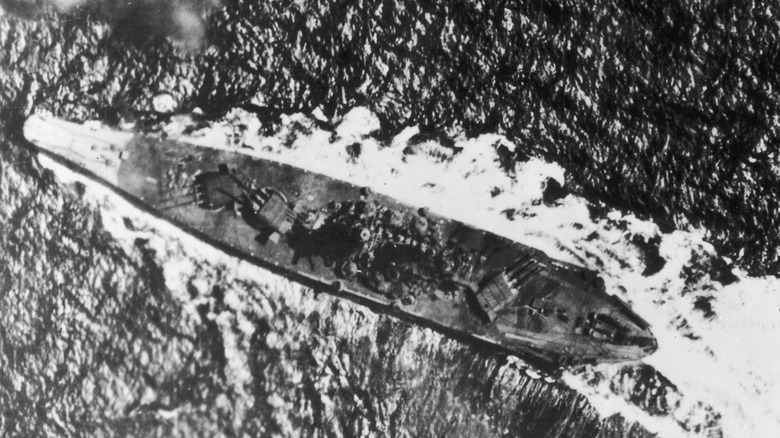5 Of The Deadliest Warships In Military History
Warships are naval vessels operated by the government that are primarily used for combat; they can range in size from tiny torpedo boats to massive aircraft carriers. Because of its armament and fighting capability, warships are the primary means of projecting military might at sea. In addition to protecting military forces from enemy forces, warships also defend merchant shipping from enemy attacks, stop the enemy from using the sea to transport military forces, and attack enemy merchant shipping. Throughout history, various navies of the world have produced powerful warships, but there are only a select few that can be categorized as some of the deadliest.
A great example of a deadly warship for modern times are the U.S. Navy's Arleigh Burke-class guided-missile destroyers. Named in honor of Admiral Arleigh A. Burke, the Chief of Naval Operations under the Eisenhower and Kennedy administrations, who distinguished himself during World War II and the Korean War. These warships are regarded as some of the most lethal vessels because of their multi-mission capability, robust weaponry, and sophisticated combat systems. A key component of its systems is the Aegis Combat System, with it, an Arleigh Burke-class destroyer is capable of tracking and engaging several targets at once.
As seen in the photo above, the USS Gravely DDG 107 is the 57th Arleigh-Burke destroyer in her class. Her keel was laid down on November 26, 2007, at Northrop Grumman Shipbuilding's Ingalls Shipbuilding facility in Pascagoula, Mississippi. The USS Gravely was launched on March 30, 2009, and she successfully finished her sea trial in June 2010. Included in its arsenal are ship-to-ship, land attack, and anti-aircraft missiles, which make this destroyer a powerful and adaptable force at sea.
HMS Queen Elizabeth Super Dreadnaught
The HMS Queen Elizabeth was a World War I super dreadnought that is now considered by many to be a significant turning point in the history of capital ship's. Laid down in 1912, and launched in October 1913, the Queen Elizabeth was completed in January 1915. She saw action in WW1 and took part in the Dardanelles Campaign in 1915, before becoming the fleet flagship of the British Grand Fleet from 1916 to 1918. The Queen Elizabeth-class dreadnoughts were the first vessels to be equipped with 15-inch guns and the first to use oil as their only fuel.
They were built in the years preceding World War I as a swift battleship to replace battlecruisers as the offensive element of the Royal Navy's battle fleet. This new class of battleship was designed to have enough firepower to destroy any existing enemy battleship. Another advantage of the class was its very accurate fire control system and its other armaments that included 16 152-millimeter guns. These were later removed and replaced with 20 dual-purpose 114-millieter quick-firing guns, all of which made a significant impact on the German High Seas Fleet during the 1916 Battle of Jutland.
As the flagship in its class, the HMS Queen Elizabeth displaced 31,100 tons, had an overall length of over 640 feet, and a beam of 90 feet, 6 inches. A distinguishing feature of the class was its heavy tripod foremast and pole-type mainmast. Four other warships of the class were built, and all of them fought in both world wars, including the HMS Barham, HMS Malaya, HMS Valiant, and HMS Warspite. A sixth planned vessel, HMS Argonaut, was never built.
Kriegsmarine Battleship Bismarck
Despite only serving eight months during World War II, the German battleship Bismarck was one of the most feared battleships of its time. Engineered to dominate enemy battleships, and attack Allied merchant convoys in the Atlantic, its speed, armor, and weapons, made it a dangerous opponent for any ship in the British Royal Navy. The Bismarck was bigger than contemporary battleships, displacing 43,978 tons as standard and 51,760 tons when fully loaded, and had an overall length of 821.85 feet, a beam of 118.11 feet, and a maximum draft of 34 feet 61 inches.
The Bismarck became infamous because of its battle with the HMS Hood. On May 24, 1941, the Bismarck sank the Royal Navy's flagship, the HMS Hood, in a single volley during the Battle of the Denmark Strait. The sinking of the HMS Hood is considered a tragedy. Due to the enormous death toll and the symbolic effect, it had on the Royal Navy and the war effort. More than 1,400 crew members perished as the vessel was destroyed in a matter of minutes. This tragic death toll made it the single largest death toll in the history of the Royal Navy.
The Royal Navy soon began plans to avenge the loss of the HMS Hood, and carried out a massive operation to locate and destroy the German battleship. Aircraft and warships were sent across the North Atlantic to locate the Bismark, and was found in just three days, on May 26, 1941. In testament to its design and engineering, it took nearly 3,000 shells during a two-hour battle to sink the Bismarck, of which at least 400 struck home. However, it was a combination of battle damage, scuttle charges, and torpedoes from HMS Dorsetshire that finally sank it.
Japanese Imperial Navy Battleship Yamato
The largest battleship ever constructed was the Japanese battleship Yamato. Known for her enormous size and powerful weapons, she was the flagship of the Imperial Japanese Navy. With a hull length of 863 feet, she was longer than all American ships of the time, except for the Iowa class. When fully loaded, Yamato displaced around 70,000 tons of water, more than 20% than even the largest Allied battleships. Her hull was so large that no Japanese shipyard could accommodate it during the 1930s, and a dockyard had to be deepened several feet to build it.
Together with its massive size, the Yamato's weaponry was equally impressive. Starting with a set of nine Type 94 main guns, these were the largest caliber cannons installed on a warship, measuring 46 centimeters. Each of the three gun turrets that held the weapons weighed 147.3 tonnes and was 69.3 feet in length. The main guns were capable of firing shells that weighed up to 3,220 pounds and had a range of up to 26 miles, and penetrating up to 17 inches of armor at 30,000 meters. This was more than enough to tear through the armor plating of the Iowa-class battleships of the time.
As the battles of the Pacific started to turn against Japan, the Yamato was ordered on a suicide mission to lure American forces to allow the land-based forces from the Japanese mainland to attack American deployments in Okinawa. To end the threat of the Yamato, the U.S. Navy's Task Force 58, with its aircraft carriers and escort fleet, searched for the ship and finally found her on April 7, 1945. In the end, it took 386 aircraft from eight aircraft carriers to sink the biggest battleship in history.
U.S. Navy Aircraft Carrier USS Gerald R. Ford
The USS Gerald R. Ford CVN 78 is the lead ship in the Ford-class of aircraft carrier. It is the first new class in more than 40 years and is considered as the most powerful warship ever built, especially among aircraft carriers. The USS Gerald R. Ford is immense; its dimensions are a length of 1,092 feet, a 134-foot beam, a 252-foot flight deck, and a height of nearly 250 feet, and its displacement is nearly 97,000 tons, nearly the same as the battleships Yamato and Bismarck put together.
The weaponry on the USS Gerald R. Ford is among the most advanced for a warship, as it is armed with a complex combination of armaments. This includes Mk 38 25-millimeter and M2.50-caliber machine guns, Phalanx close-in weapon systems CIWS, and the Rolling Airframe Missile, and the Evolved Sea Sparrow Missile. However, its most powerful arsenal is the aircraft it can carry, which can include combat aircraft like F-35, F/A-18E/F Super Hornet, surveillance planes like the E-2D Advanced Hawkeye, EA-18G Growler, and MH-60R/S helicopters, and unmanned air and combat vehicles.
Along with being the biggest ship in the U.S. Navy, the USS Gerald R. Ford is also among the most expensive, costing more than $13 billion to build. Operated by a crew of 2,600 people, including 508 officers and 3,789 enlisted soldiers, the ship is the most capable and versatile combat platform in the world, continuously demonstrating U.S. naval power throughout the world. The Ford class of carriers were built to replace the 50-year-old Nimitz class, and is expected to have the same service life. This means the USS Gerald R. Ford will be one of the deadliest ships in the world for a long time to come.




